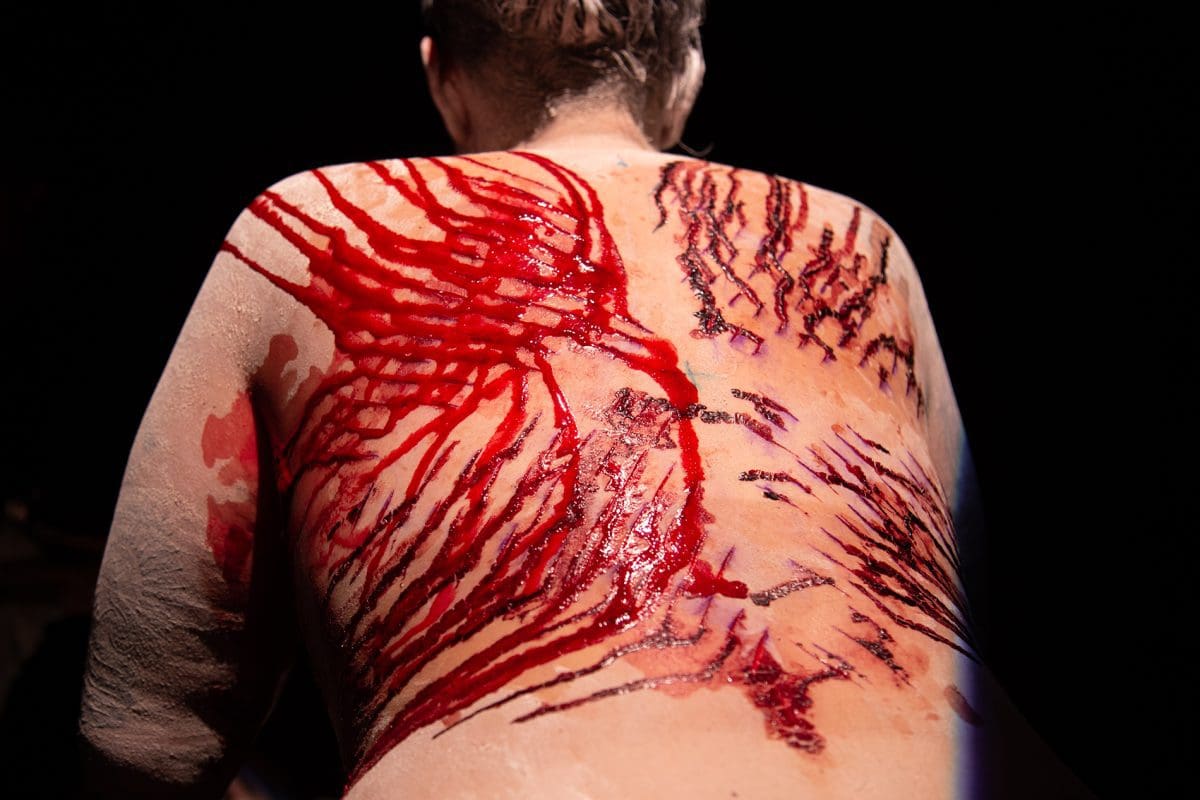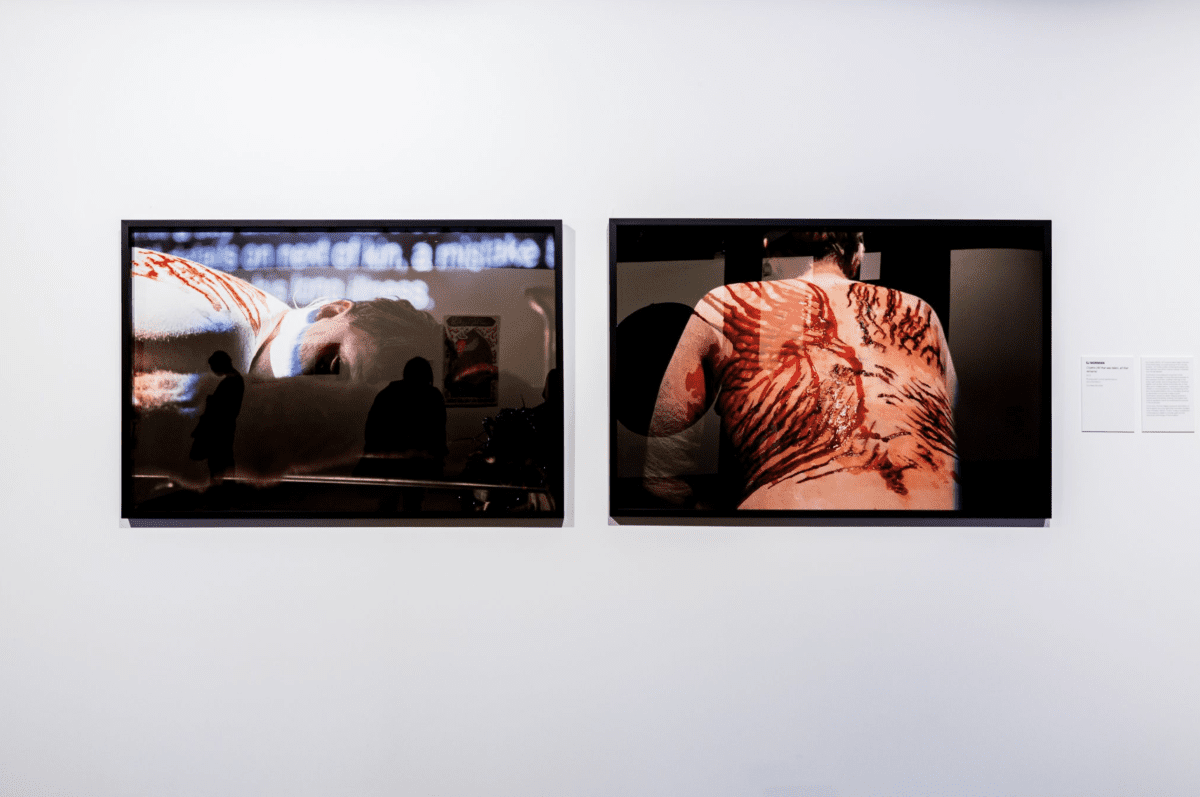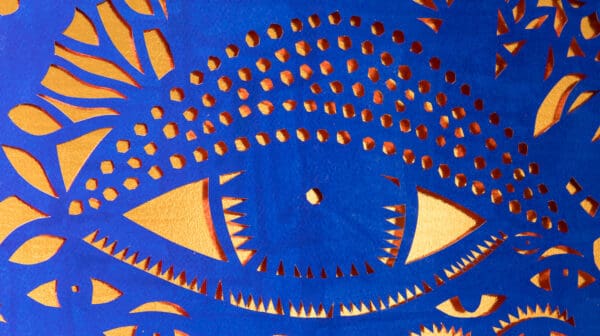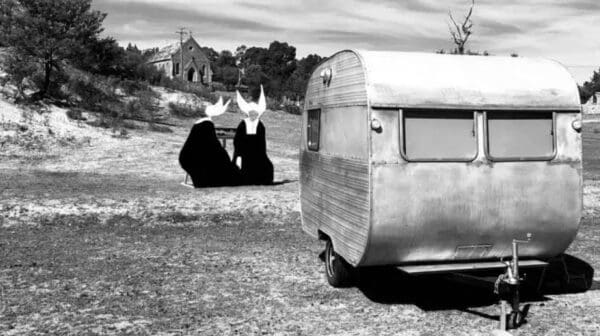Wiradjuri artist S.J Norman recently won the 67th Blake Prizefor his work Cicatrix (All that was taken, all that remains). Showing at Sydney’s Casula Powerhouse Arts Centre, the Blake Prize is awarded to artworks exploring experiences of spirituality, religion, and belief. The winning photographic diptych by Norman was created during a four-hour performance in New York City in 2019. The photographs document the 147 incisions made on the artist’s back during the performance: 147 incisions to mark the 147 Aboriginal people who died in police custody in the decade preceding the performance.
The performance and photographic documents were created in light of Norman’s mourning the death of his uncle and honouring his legacy. Like much of the work in the Norman’s formidable 15-year cross-disciplinary practice, Cicatrix (All that was taken, all that remains) interrogates how art can examine and disrupt systems of social power. Wiradjuri poet and artist Jazz Money sat down with Norman to discuss the significance of these images.
S.J Norman: I didn’t expect Cicatrix to win the Blake Prize. I entered the Blake Prize because I wanted the work to be in the exhibition. I wanted to see, and have the work seen, in the context of religious art. This is a piece of art that is about transmuting grief and holds references to a ceremonial practice that we [as Aboriginal people] have been divested of in the south-east [of Australia]. It’s a practice that is still extent in many parts of this continent—it is a beautiful practice, a very poetic practice. Many cultures on many continents have faith traditions of flesh modification and this work is part of that. I was interested to see what it would be to throw this work into that context of the Blake Prize and see how it was responded to. The last thing I expected was for it to win. I have a lot of joy and gratitude, and I’m trying to actually sit in that and accept that honour.
Jazz Money: It’s fascinating to me that Cicatrix won. Particularly due to the complexity of how our ceremonies have been understood and categorised by the white settler colony. So often our spirituality is not spoken of as religion.
SJN: On the one hand, I think we have a lot of really good reasons for not wanting to engage with a heavily loaded word like ‘religion’. But on the other hand, when we talk about ‘spirituality’ the particular semiotics of that word and how it is understood, it somehow sands the edges off the significance of what we’re engaging with. If there is a differentiation between religion and spirituality what does that differentiation even mean in the context of something like the Blake Prize?
JM: It sounds like the difference between sociology and anthropology, right?
SJN: Those distinctions are Western distinctions. For us, it’s entangled: it’s religion, it’s spirituality, it’s culture, it’s politics.
JM: Yes, and those are distinctions that exist to suit a very particular colonial ideology.
SJN: It doesn’t suit the Western narrative to see spirituality with any kind of legitimacy, you know? The colonial understanding of spirituality for Indigenous people is often treated as savagery or superstition, and so there is power in subverting that language that frames spirituality in Indigenous life. It’s interesting to sit with that and say, “No, this is absolutely a religious practice.” To throw down that word with all its ramifications and see what happens when entering a prize like this.
JM: To play with those tensions, perhaps? Have you noticed any tensions playing out in the wake of winning the Blake Prize? What has the reception to Cicatrix been like?
SJN: I’ve certainly found that there’s been a resistance to my work within some realms of the institutional art world. That is for a variety of reasons, and I suspect that some people don’t understand the work, and perhaps there’s a preoccupation with what I think they imagine to be the shock factor?
Which is interesting and vexing to me, because I’m not someone who’s invested in shock value. I think my work is quite gentle. And a lot of people who have experienced my work would say the same thing. I try to work in a very gentle, very considered, very nuanced kind of way. I do work with the body in quite explicit ways and I’m not shy that I’m interested in the body as material—but unfortunately that kind of leads to sometimes a pretty one-dimensional interpretation.
This work is not about blood. It’s a work about collective grief, and about the way that grief is held in the body. It’s a very personal reclamation of a very sacred practice. I’m not interested in spectacle and I’m certainly not interested in spectacles of pain, which I think is a misapprehension that a lot of people have about my body-based work. What I’m actually really interested in is transaction and how power operates.
JM: So Cicatrix is a photographic diptych that was part of a much larger performance you undertook in New York City in 2019, when you were mourning the death of your uncle. How did the performance come about?
SJN: My uncle Don Clark was a very important senior man in my life and he passed away earlier that year under foul circumstances. I made the work largely to honour him and to honour the work that he did, particularly around Blak deaths in custody. What won the Blake Prize was the photographic diptych taken by Ricardo Martinez Roa at Performance Space NY.
In January 2018 I was part of the inaugural First Nations Dialogues lead by Merindah Donnelly and Emily Johnson, which led to later collaborations. I had managed to pull together some funding to bring over an ensemble to Lenapehoking (New York). Carly Sheppard was the one who did the scarification on my back, she was the one who held the blade. Naretha Williams did the live score. Joshua Pether and Mykaela Saunders were both brought into the space. We worked with local Kuna Rappahannock Elder Aunty Muriel Miguel. And we worked with Inuit tattooist Holly Nordlum. The audience either had to make a monetary donation to a local abolitionist organisation or they had to make a donation of skin and blood.
There was a bunch of people that were present for that action who then subsequently became really important people in my life and in my creative cultural networks. It was really, really powerful, and connected many people who are now orbiting each other in a huge variety of ways. It was a very ceremonial four hours with many components. But these photos are just one aspect of a performance that had many things going on.
JM: What you’re describing sounds so incredible. I have always found ceremony very hard to talk about afterwards with people who weren’t there. Somehow the secret/sacred feels built into certain spaces.
SJN: I think there’s a reason why there is very little information out there in the world about the performance that took place. Those images were taken from something that occurred for the people who chose to be present and chose to make offerings of their own. That is not to say that it doesn’t have echoes that reach out into the world from that moment in time. These images are a part of that, but they are an artifact produced by that action. The same as the tattoos are a residue of that action, the same as the scars on my back are a residue of that action. And another way the performance echoes through the world are those images.
JM: In your work do you think about the body as a canvas or a message? Or something totally beyond that?
SJN: I think a lot about the body as a site. As a site and as a space that I am involved in exploring. Not just my body, but the inter-corporeality—the space that exists between bodies and what’s activated in that space—and the space between body and land. My physical body versus my ancestral body, my spiritual body, my energetic body, all of those things.
In regards to the images in Cicatrix, when that action was taking place, there was no message. It was an action that I was doing and that other people were witnessing and participating in and had their own things to offer to that space. It was a process that involved my physical body and involved the physical bodies of everybody who was present.
The message perhaps happens later. It’s very important to note also that those 147 incisions were specifically referencing that number. Just that number. I was never saying that every one of these cuts stands in for a person, it’s not for me to do that. The reference is a number and the question is about what does it mean to treat bodies like numbers? What is the weight of hard data on the body when the data that you’re dealing with is like mass incarceration and…
JM: …not names, not communities, not cultural impact.
SJN: I think a lot of the time my work hasn’t existed as images. Instead it has existed as stories, as the recounting of the work. The iterations of the story about something that has occurred. And people will have varied responses to that, and they’re entitled to that because it’s an artwork. Because I produced an artwork out of a very personal experience and a cultural experience.
JM: Did it help you heal from that grief in some way?
SJM: Yes it did. Yes, absolutely it did.
JM: That’s very powerful. And very powerful to share that space with others. To honour relations and to create relationships in this way.
SJN: Those relationships that I’ve made, that’s all folded into the work for me. That is the work. Everything that I do is responding to, and moving through, place and relationship. That’s the biggest joy of my practice. All those people, all those names, all those experiences, that’s it for me. The event itself is also a part of that lineage. We’re never the first people to do things.
S.J Norman’s winning work is showing in the 67th Blake Prize exhibition, alongside all finalist works in the prize.
The 67th Blake Prize
Casula Powerhouse
Until 22 May











